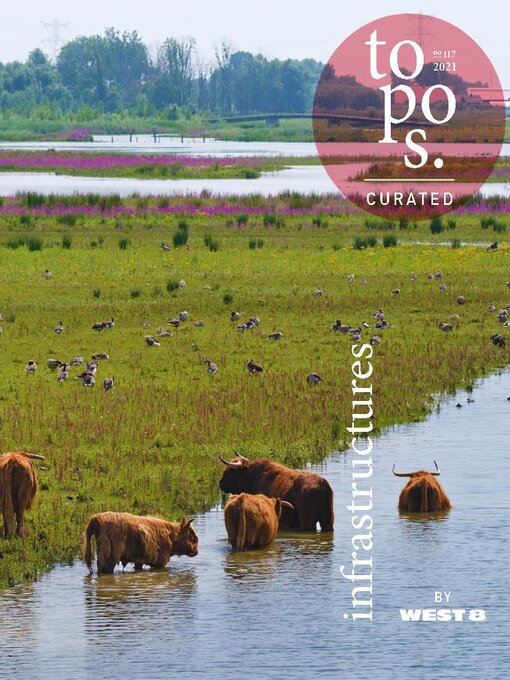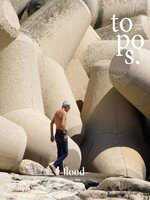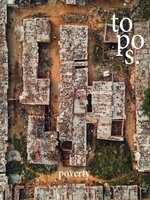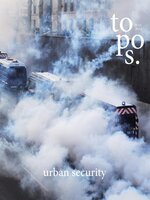Topos is a must-have for successful landscape architects, planners, urban designers and architects all over the world.The monothematic issues provide a global overview of innovative projects, new developments and trends in the profession. Be part of the worldwide community of Topos readers!
Editor Letter
Engineer meets Poet WEST 8 • From the day West 8 was founded in 1987 we have consciously applied systemic thinking in the fields of public space and urban design. In the last 30 years the ways in which cities and infrastructure have been designed and built seemed to prioritize efficiency and speed, reduce friction and cost for consumers and support development. As a result of these shifts in infrastructural demands, we, as landscape architects and urban designers, have inevitably taken part in their development. Our role has been to fearlessly lead with vision, argue with practicality, never forget the poetry of place and identity, while daring to challenge the status quo. On the following pages we reflect on more than three decades of global phenomena and how they have taken shape within our work.
CREATING LIVING INFRASTRUCTURES • Houston Botanic Garden, Houston, Texas, USA 2015 - present (Phase 1 opened in 2020)
GREEN LUNG FOR THE CITY • Governors Island, New York, New York, USA 2007 - 2015, ongoing
GIVING THE RIVER BACK TO THE PEOPLE • Madrid Rio River Revitalization, Madrid, Spain 2005 – 2011
SIGNATURE CITY SPINES • left: Coolsingel, Rotterdam, the Netherlands, 2014 – present right: Toronto Central Waterfront, Canada, 2006 – present
FROM INDUSTRIAL DOCK TO GREEN JEWEL • Xinhua Waterfront Park, Shanghai, China 2016 - 2019
CLIMATE ADAPTATION FOR THE 21ST CENTURY DELTA • Noordwaard Polder, the Netherlands 2011 - 2015
A HEALING HIGHWAY • Groene Loper (Green Carpet), Maastricht, the Netherlands 2005 - 2018, ongoing
FROM MACRO TO MICRO • Afsluitdijk, North Sea / IJsselmeer, the Netherlands 2017 - Present
Clover21 • The complex realities of the built environment over the next hundred years include large scale urbanization, the ongoing aftermath of colonization and globalization, rapid digitization, the climate crisis, rising sea levels and environmental uncertainty. The infrastructural responses must aspire to be the multi-layered, fluid bloodlines of our cities, countries and waters. They demand a systemic approach that is equal parts pragmatism and imagination, equal parts new technology and ancient craft, equal parts science and art. We call it CLOVER21 – a cumulative manifesto for designing the city of the 21st century.
Why do we need CLOVER21? We are all Infrastructure
Eindhoven: The 21st Century City
Climate Future and the Digital Civic Universe • This article sets forth the proposition for a digital civic universe (DCU) as a both common data ontology and a hybrid spatial medium for integrating the three and four dimensions of state-sponsored climate adaptation plans, civic adaptation realities and design interventions in the built environment. The authors, taking the U.S. as example, state that City Adaptation Maps (CAM) and National Adaptation Maps (NAM) conceptualized as a DCU platform could offer new ways for designing an adaptive and sustainable future.
Keep it clean: Landscapes of decarbonization • According to a recent report issued by the International Energy Agency, human societies must reach net-zero carbon emissions by the year 2050 in order to avoid the most catastrophic effects of climate change.1 Achieving this goal will require a fundamental reconfiguration of the global energy landscape; hence, potential pathways toward decarbonization have emerged as a subject of intense debate. Some advocate on behalf of a “net-zero” framework, which seeks to balance continued fossil fuel production with infrastructures of...

 N. 132
N. 132
 N. 131
N. 131
 N. 130
N. 130
 N. 129
N. 129
 N. 128
N. 128
 N. 127
N. 127
 N. 126
N. 126
 N. 125
N. 125
 N. 124
N. 124
 N. 123
N. 123
 N. 122
N. 122
 N. 121
N. 121